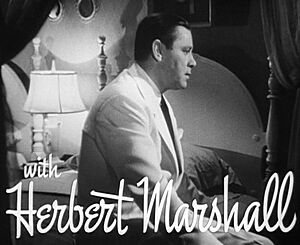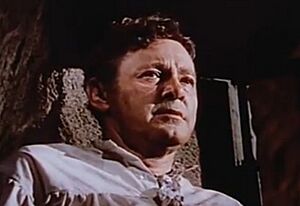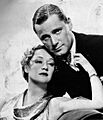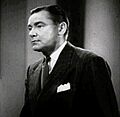Herbert Marshall facts for kids
Quick facts for kids
Herbert Marshall
|
|
|---|---|
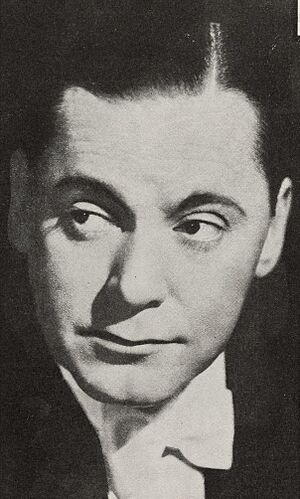
Marshall in 1934
|
|
| Born |
Herbert Brough Falcon Marshall
23 May 1890 London, England
|
| Died | 22 January 1966 (aged 75) |
| Occupation | Actor |
| Years active | 1911–1965 |
| Spouse(s) |
Mollie Maitland
(m. 1915; div. 1928)Edna Best
(m. 1928; div. 1940)Lee Russell
(m. 1940; div. 1947)Boots Mallory
(m. 1947; died 1958)Dee Anne Kahmann
(m. 1960) |
| Children | 2, including Sarah Marshall |
Herbert Brough Falcon Marshall (May 23, 1890 – January 22, 1966) was a famous English actor. He worked in plays, movies, and radio. He became a big star in Hollywood during the 1930s and 1940s, often playing charming romantic leads. Later in his career, he took on many different kinds of roles.
He is well-remembered for his parts in classic films like Trouble in Paradise (1932), Murder! (1930), Foreign Correspondent (1940), The Letter (1940), and The Little Foxes (1941). He acted alongside many of Hollywood's biggest female stars, such as Greta Garbo, Marlene Dietrich, Joan Crawford, and Bette Davis.
From 1944 to 1952, Herbert Marshall had his own radio show called The Man Called 'X'. He was known for his clear, pleasant voice and appeared on many other radio and TV shows. He married five times. During World War I, he was injured and lost a leg. Later, during World War II, he helped other injured soldiers, especially those who had also lost limbs. In 1960, he received a star on the Hollywood Walk of Fame.
Contents
Early Life and Acting Start
Herbert Marshall was born in London in 1890. His parents, Percy F. Marshall and Ethel May Turner, were both actors. His father was known for his funny acting and "rich voice." Herbert's mother gave him the nickname "Bart" because she didn't like the name "Bertie." His family and friends called him Bart for the rest of his life.
As a child, Herbert was raised by his three aunts while his parents traveled for their acting jobs. He sometimes joined them during school breaks. These early experiences made him dislike the theater at first. He remembered feeling "tired and cold" and seeing "heartache and poverty" in the acting world.
Starting His Career
After attending St Mary's College in Harlow, Essex, Marshall first worked as an accounting clerk. He was fired for being too slow. Then, he got a job helping manage a theater group run by a friend of his father's. He worked many different jobs behind the scenes in theaters.
When he lost his job, he decided to try acting. In an interview, he said he only became an actor because he didn't know how to do anything else. He had once promised himself he would never go on stage.
Marshall had a long and varied career in theater. He worked with many famous actors like Noël Coward and Edna Best, who later became his second wife. His first stage appearance is usually listed as The Adventure of Lady Ursula in 1911. In 1913, he made his London debut in Brewster's Millions. A famous actor-manager, Cyril Maude, was so impressed that he invited Marshall to join his tour in the U.S. and Canada. When World War I began, Marshall returned to London and joined the London Regiment.
War Injury and Recovery
Marshall served with the London Scottish regiment. He fought on the Western Front in France. On April 9, 1917, he was shot in the left knee by a sniper during the Second Battle of Arras. After several operations, doctors had to amputate his leg. Marshall stayed in the hospital for 13 months.
He later shared that he was very sad and bitter about losing his leg at first. But soon, he decided he wanted to return to acting. He learned to walk well with a prosthetic (artificial) leg. While he was recovering, King George V visited the hospital. When the king was asked to guess which of Marshall's legs was artificial, he picked the wrong one! Throughout his career, Marshall mostly kept his prosthetic leg a secret, though it was sometimes mentioned in the news.
Marshall dealt with pain from his injury for the rest of his life. He sometimes had "phantom pain," which is common for amputees. He also had discomfort from the prosthesis. He even kept holes in his trouser pockets so he could secretly loosen a strap on his artificial leg to ease sudden pain.
Back to Acting
Theater Success
After the war, Marshall joined a theater group and appeared in several plays. In 1920, he first acted with Edna Best in Brown Sugar. He also performed in Shakespearean plays like The Merchant of Venice and As You Like It. He said playing Jaques in As You Like It gave him "more pleasure than any part" he had played.
By 1922, Marshall was acting regularly in both London and New York. He made his Broadway debut in The Voice from the Minaret. He had many successful plays, especially with Edna Best, including The Charming People (1925–26) and Michael and Mary (1930).
Early Films
In 1927, Marshall made his first movie appearance in the British silent film Mumsie. Two years later, he made his first American film, The Letter (1929).
After that, he returned to Britain and starred in Alfred Hitchcock's Murder! (1930). He then went back to Hollywood to make Secrets of a Secretary (1931). In Britain, he made three more films with Edna Best: Michael and Mary (1931), The Calendar (1931), and The Faithful Heart (1931). After these, he mostly made films in the United States.
Hollywood Romantic Roles
In Hollywood, Herbert Marshall became a popular leading man. He often played smooth, gentlemanly romantic roles. He acted opposite huge stars like Claudette Colbert, Marlene Dietrich, Greta Garbo, Barbara Stanwyck, Katharine Hepburn, Joan Crawford, and Bette Davis in the 1930s and early 1940s.
His role in Blonde Venus (1932) made him famous across America. Later that year, he played Gaston Monescu, a clever thief, in Ernst Lubitsch's comedy Trouble in Paradise (1932). Marshall often said he preferred playing these witty comedy roles.
He also appeared in Evenings for Sale (1932) and briefly returned to England for I Was a Spy (1933). Back in Hollywood, he starred in films like The Solitaire Man (1933) and Four Frightened People (1934) with Claudette Colbert.
He made several films with Greta Garbo, Norma Shearer, and Constance Bennett. Marshall often played kind husbands. He told reporters he was tired of these "gentleman" roles, but he liked his part in The Painted Veil (1934) with Garbo because his character showed strength.
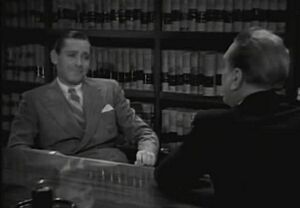
Other popular films from this time include The Good Fairy (1935), The Dark Angel (1935), and If You Could Only Cook (1935). He also made three films with Gertrude Michael and acted with Ruth Chatterton and Katharine Hepburn.
By the mid-1930s, the news often mentioned how popular he was as a romantic actor. One writer said that even new, younger actresses wanted him to appear in their movies. Another called him the "vogue in leading men."
Marshall reunited with Dietrich and Lubitsch in Angel (1937). He also made Breakfast for Two (1937) and Always Goodbye (1938) with Barbara Stanwyck.
World War II and Beyond
In the 1940s, Marshall started taking on different kinds of roles, not just romantic leads. He supported Maureen O'Hara in A Bill of Divorcement (1940) and played a villain in Hitchcock's Foreign Correspondent (1940). One of his most famous roles was as Bette Davis' husband in The Letter (1940).
After Adventure in Washington (1941), Marshall starred as Horace Giddens in The Little Foxes, again with Bette Davis. This film was nominated for nine Academy Awards. Critics praised Marshall's performance as a "suffering, dying man."
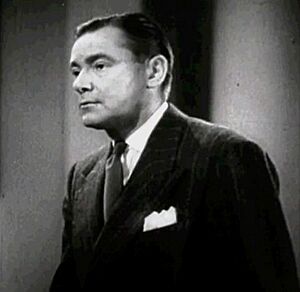
During World War II, Marshall made many appearances on the Armed Forces Radio Service (AFRS). He hosted The Globe Theatre and was a guest on other shows. He also helped lead a Hollywood committee that organized help for British war efforts. In 1940, he acted in a play to raise money for the British Red Cross. In 1943, he appeared in the film Forever and a Day, whose profits went to war charities. He also helped sell Canadian war bonds in a short film called The Shining Future (1944).
Marshall continued to act in films during the war, often in supporting roles. These included When Ladies Meet (1941), Kathleen (1941) with Shirley Temple, and The Moon and Sixpence (1942).
Radio Career
Marshall began working in radio in 1936. He appeared on many popular shows like Lux Radio Theatre and The Screen Guild Theatre. In July 1940, he made radio history as the narrator of "The Lodger," the first audition show for the Suspense series.
His most famous radio role was as Ken Thurston, a global intelligence agent, in The Man Called 'X' (1944–52). In this show, Thurston worked for an agency called "The Bureau" and dealt with dangerous criminals like smugglers, murderers, and spies. The show was not just for fun; it also warned people about the dangers of peace after war.
Helping Amputees
Using his own money, Marshall visited many military hospitals during the war. He especially focused on encouraging soldiers who had lost limbs. He wanted them to stay positive and not feel limited by their injuries. Even though he usually didn't talk about his own injury, he shared his experiences to give tips on using and adjusting to artificial limbs.
A 1945 article in Motion Picture Magazine reported on his work, even though Marshall preferred to keep it private. The author felt his story needed to be told to help injured veterans. One young officer said, "Herbert Marshall gave me back my life." He praised Marshall for showing him that he could lead a normal life even with a metal hand. Another veteran, who had lost both a leg and a foot, thanked Marshall for teaching him how to dance with a prosthetic leg. General Dwight D. Eisenhower was very impressed with Marshall's efforts during the war.
Later Career
After the war, Marshall mostly worked as a supporting actor in films. Some of these included Crack-Up (1946), The Razor's Edge (1946), and the Western Duel in the Sun (1946). He also appeared in The Secret Garden (1949) and Anne of the Indies (1951).
Television Appearances
Starting in 1950, Marshall also began acting on television. He appeared in shows like Robert Montgomery Presents and The Ford Television Theatre. In November 1954, he was a "mystery guest" on the popular game show What's My Line?.
He continued to make films such as Angel Face (1953), the sci-fi movies Riders to the Stars (1954) and Gog (1954), and The Virgin Queen (1955) with Bette Davis. He received praise for his roles in Stage Struck (1958) and the horror film The Fly (1958).
However, he appeared more often on television in shows like Playhouse 90, Studio One in Hollywood, and Alfred Hitchcock Presents.
1960s Roles
Marshall's final performances included films like College Confidential (1960), Midnight Lace (1960), and Five Weeks in a Balloon (1962). He also guest-starred on TV shows such as Hong Kong and 77 Sunset Strip. In 1964, he said, "They don't seem to make my kind of pictures any more."
His very last performance was in the film The Third Day (1965).
Personal Life
Herbert Marshall was known as a quiet, charming, and professional man. He was widely respected and liked by his friends and colleagues in Hollywood. He had a pleasant and easygoing personality, a witty sense of humor, and was very courteous. Among his many friends were Ronald Colman, David Niven, Bette Davis, and Joan Crawford. Even though he was popular, Marshall sometimes struggled with sadness throughout his life. In his free time, he enjoyed sketching and fishing.
Marriages and Family
Marshall was married five times and divorced three times. In 1915, he married Mollie Maitland. Five years later, he began acting with Edna Best, who became his most frequent stage partner and later his second wife in 1928. They made three films together. In 1931, Edna Best left a big movie contract to be with Marshall in New York, showing how much they loved each other.
After a long separation, Best divorced Marshall in 1940. Twenty days later, he married Elizabeth Roberta "Lee" Russell, who was the sister of actress Rosalind Russell. They divorced in 1947, but remained friendly. Lee Russell told the press, "I will never say anything against Bart. He is one of the most charming people I have ever known."
His fourth wife was actress Boots Mallory, whom he married in 1947. She passed away in 1958 after a long illness. Marshall was very sad about her death and had to be hospitalized himself. He married his final wife, Dee Anne Kahmann, in 1960 when he was almost 70 years old. They stayed married until his death.
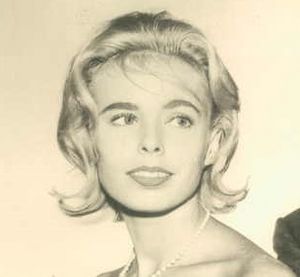
Marshall had two daughters. His daughter Sarah was with Edna Best. Sarah followed her parents into acting and appeared in many popular TV shows like Star Trek and The Twilight Zone. Herbert and Sarah even acted together in a TV play in 1951. His younger daughter, Ann Marshall, worked for many years as Jack Nicholson's personal assistant. Marshall also had step-children from his marriages. His grandson, Timothy M. Bourne, is a film producer who was the executive producer of the Academy Award-winning film The Blind Side (2009).
Later Years and Passing
After World War II, the movie industry changed, and Marshall, like many older actors, received fewer roles. He sometimes had to take any job he could get for money. In May 1951, he had a serious health issue while in the hospital. His friends Van Heflin, John Lund, and Joseph Cotten filled in for him on his radio show until he could return.
Marshall's last important film role was in The Caretakers (1963) with Joan Crawford. She was happy to work with him again and helped the director make sure Marshall didn't have to spend too much time on set because of his poor health.
In late 1965, after his final brief film appearance in The Third Day, Marshall was admitted to a hospital for severe sadness. Eight days after being released, he passed away on January 22, 1966, in Beverly Hills, California, from heart failure. He was 75 years old.
He was buried at Chapel of the Pines Crematory in Los Angeles.
Filmography
| Year | Title | Role | Notes |
|---|---|---|---|
| 1927 | Mumsie | Colonel Armytage | Lost film |
| 1929 | The Letter | Geoffrey Hammond | |
| 1930 | Murder! | John Menier | |
| 1931 | Secrets of a Secretary | Lord Danforth | |
| The Calendar | Gerry Anson | Released as Bachelor's Folly in US | |
| Michael and Mary | Michael Rowe | ||
| 1932 | The Faithful Heart | Waverly Ango | Released as Faithful Hearts in US |
| Blonde Venus | Edward 'Ned' Faraday | ||
| Trouble in Paradise | Gaston Monescu | ||
| Evenings for Sale | Count Franz von Degenthal | ||
| 1933 | I Was a Spy | Stephan | |
| The Solitaire Man | Oliver Lane | ||
| 1934 | Four Frightened People | Arnold Ainger | |
| Riptide | Lord Rexford | ||
| Outcast Lady | Napier | ||
| The Painted Veil | Dr. Walter Fane | ||
| 1935 | The Good Fairy | Dr. Max Sporum | |
| The Flame Within | Doctor Gordon Philips | ||
| Accent on Youth | Steven Gaye | ||
| The Dark Angel | Gerald Shannon | ||
| If You Could Only Cook | Jim Buchanan | ||
| 1936 | The Lady Consents | Dr. Michael J. Talbot | |
| Till We Meet Again | Alan Barclay | ||
| Forgotten Faces | Harry Ashton | ||
| Girls' Dormitory | Doctor Stephen Dominik | ||
| A Woman Rebels | Thomas Lane | ||
| Make Way for a Lady | Christopher 'Chris' Drew | ||
| 1937 | Angel | Sir Frederick Barker | |
| Breakfast for Two | Jonathan Blair | ||
| 1938 | Mad About Music | Richard Todd / Mr Harkinson | |
| Woman Against Woman | Stephen Holland | ||
| Always Goodbye | Jim Howard | ||
| 1939 | Zaza | Dufresne | |
| 1940 | A Bill of Divorcement | Gray Meredith | |
| Foreign Correspondent | Stephen Fisher | ||
| The Letter | Robert Crosbie | ||
| 1941 | Adventure in Washington | John Coleridge | |
| The Little Foxes | Horace Giddens | ||
| When Ladies Meet | Rogers Woodruff | ||
| Kathleen | John Davis | ||
| 1942 | The Moon and Sixpence | Geoffrey Wolfe | |
| 1943 | Forever and a Day | Curate in Air Raid Shelter | |
| Flight for Freedom | Paul Turner | ||
| Young Ideas | Michael Kingsley | ||
| 1944 | Andy Hardy's Blonde Trouble | Doctor M.J. Standish | |
| The Shining Future | Himself | Short, Uncredited | |
| 1945 | The Enchanted Cottage | Major John Hillgrove | |
| The Unseen | Doctor Charles Evans | ||
| 1946 | Crack-Up | Traybin | |
| The Razor's Edge | W. Somerset Maugham | ||
| Duel in the Sun | Scott Chavez | ||
| Monuments of the Past | Narrator | Documentary | |
| 1947 | Ivy | Miles Rushworth | |
| High Wall | Wilard I. Whitcombe | ||
| 1949 | The Secret Garden | Archibald Craven | |
| 1950 | The Underworld Story | E. J. Stanton | |
| Black Jack | Doctor James Curtis | Released as Captain Blackjack | |
| 1951 | Anne of the Indies | Doctor Jameson | |
| 1953 | Angel Face | Mr. Charles Tremayne | |
| 1954 | Riders to the Stars | Doctor Don Stanton | |
| Gog | Doctor Van Ness | ||
| The Black Shield of Falworth | William, Earl of Mackworth | ||
| 1955 | The Virgin Queen | Robert Dudley | |
| 1956 | Wicked as They Come | Stephen Collins | |
| The Weapon | Inspector Mackenzie | ||
| 1957 | Alfred Hitchcock Presents | Judge Connors | Season 2 Episode 19: "A Bottle of Wine" |
| 1958 | Alfred Hitchcock Presents | Colin Bragner | Season 3 Episode 39: "Little White Frock" |
| Stage Struck | Robert Harley Hedges | ||
| The Fly | Inspector Charas | ||
| 1960 | College Confidential | Professor Henry Addison | |
| Midnight Lace | Charles Manning | ||
| 1961 | A Fever in the Blood | Governor Oliver P. Thornwall | |
| 1962 | Five Weeks in a Balloon | The Prime Minister | |
| 1963 | The List of Adrian Messenger | Sir Wilfrid Lucas | |
| The Caretakers | Doctor Jubal Harrington | ||
| 1964 | The Presidency: A Splendid Misery | George Washington | TV documentary |
| 1965 | The Third Day | Austin Parsons |
Radio Credits
| Year | Programme | Episode/source |
|---|---|---|
| 1940 | Forecast* | The Lodger |
| 1941 | The Jell-O Program | 2 February episode; substitutes for Jack Benny as master of ceremonies |
| 1946 | Hollywood Star Time | Intermezzo |
| Hollywood Star Time | Bedelia | |
| 1951 | The Jell-O Program | 16 February episode; at surprise birthday party for Jack Benny |
| 1953 | Suspense | The Mystery of Edwin Drood |
| Suspense | The Dead Alive |
- Audition program for the Suspense radio program.
Images for kids
-
Marshall and Frank Morgan in The Good Fairy (1935)
-
Marshall in the trailer for Foreign Correspondent (1940)
-
Daughter Sarah Marshall in 1961
See also
 In Spanish: Herbert Marshall para niños
In Spanish: Herbert Marshall para niños



